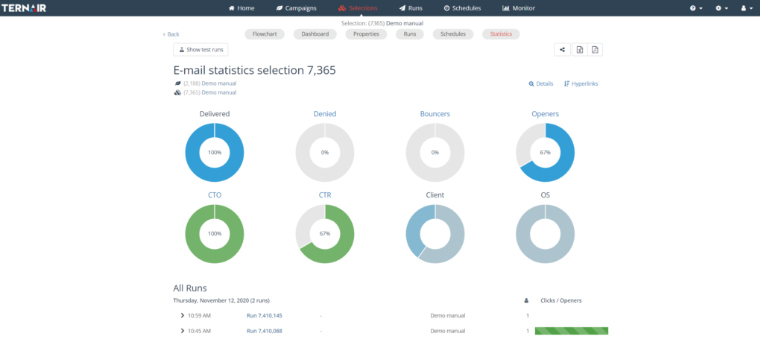Measuring email traffic

With the arrival of Apple Mail Privacy Protection, it becomes even more important for email marketers to have a good idea of the amount of traffic emails bring to your websites, landing pages and apps. You normally measure in two ways: the “clicks” your email sender (Email Service Provider – ESP) indicates in the statistics of your emailing and the email traffic on your site measured by web analysis programs such as Google Analytics. Ideally, the two will match, but certainly not always. How come? We’ll go into that in more detail in this article.
What is a “Click”?
A Click means a recipient clicks on a link in an email that you have sent. Looking at your stats, the Click Through (Open) Rate tells you how many people actually respond to the email relative to the number of emails sent or opened. Note, there are two ways to look at the statistics: the total number of clicks and the unique clicks. The unique clicks record how many individual recipients clicked on different links in your email. If a recipient clicks once on a link and twice on another link, two unique Clicks are recorded. Total Clicks doesn’t take individual recipients into account and simply adds up all clicks, even if someone clicks on the same link ten times. Of course, the destination URL was opened ten times.
When you send an email, the email sender (ESP) looks at the HTML of the email and converts any found links into traceable links. That means the email is converted into a longer link. When the recipient clicks on the link, his browser first visits the ESP server before being redirected to the website. This happens so quickly that the user is not bothered by it. For example, your ESP records how often and which links are clicked and by which recipient. And that is exactly what you as a sender wants to know. If the link goes to a website that contains a tracking script, it is also recorded. This way you can keep track of your complete conversion up to the moment of download or purchase. At Ternair we use the TID (Ternair ID) for this.

Measuring in Google Analytics
You can also keep track of traffic from email to your website in web analysis programs. But from the other side. The moment the browser registers a visit, the link is checked to see if information is available that can determine where the visit comes from. If the link contains only the URL of the website, this will be registered as Direct Traffic. If the link contains an extra parameter in the form of a code, it indicates whether the link comes from a Google search (Organic), a reference from another website (Referral), an Email, an Advertisement or a Social Media message. You can see this in detail under the Traffic Acquisition heading of your web analytics program.
Both are wonderful methods that give you very precise information about your visitors, and therefore about use of each of your channels. However, therein lies the problem.
Differences in measurements
Suppose you’ve been tracking these stats for ages and suddenly you notice significant differences between what your email sender (ESP) and your web stats program is reporting. What are you supposed to do with that? Which source is right? And what can you report about this internally to colleagues and managers? Is it going well or not?
Although the matter is technically quite complex, there are a few explanations that explain most of the differences. In some cases you can do something about it yourself, in other cases you can’t. But at least you know where it comes from.
We will discuss the following causes below:
- Bot clicks
- Tagging
Bot clicks
As mentioned, ESPs keep track of when and which links in your email recipients are clicking. Of course you assume there are actual readers are behind these clicks. Unfortunately, that is not always the case. There is software that automatically opens and clicks after receiving an email. These are clicks from a robot, and we call them “bot clicks”. Since 2019, there has been a huge increase in the number of bot clicks in email.
Because bot clicks don’t present themselves as robots, ESP’s set rules when a click is seen as a bot click. It is not the target group of your email and that is why they distort the real result of your emailing. For example, we look at how fast an email is opened and clicked. If the email was opened within a second and clicked three times after it was sent, you can imagine it is not a human act. Then the IP address of this recipient is registered as a Bot IP and is no longer included in the statistics. We also apply such rules at Ternair and keep them up-to-date.
It is certainly not the case that all bots are all ‘bad’, if you have got that idea. Google’s bots index websites daily to rank them in organic search results. For email, bots are designed to identify links to malware or phishing attacks and thus prevent them from reaching a recipient’s inbox. Then it is for security reasons.
While generic agreements between ESPs on methods to identify bot clicks are ongoing, there are no general rules. And because the bots are also becoming more advanced, the rules must also be adjusted regularly. The Apple-introduced Mail Privacy option in iOS15 is another example of this. In that case, however, it does not concern the Clicks, but the registered Opens. Apple does this for privacy reasons.
The same applies vice versa. A program like Google Analytics is constantly trying to distinguish incoming bot traffic from human traffic on websites. Algorithms are developed for this reason. This also indicates directly why there are differences between email statistics and the measured email traffic on the website. Different ways to exclude bot clicks from the statistics give different results. Especially when ESPs or web analysis programs make major changes, major differences can occur. If you use multiple ESPs, it becomes even more complicated to differentiate in Analytics.

Tagging
As described earlier, when people land on a website a program like Analytics looks at the URL to determine the origin of the visitor. This means that link URLs from email should be tagged. The most common method is utm tagging. In any case, information must be given to the link URL in order to be able to recognize it as email traffic for the analysis programs.
This is often forgotten or content marketers and email editors have not heard it is necessary. In that case, Analytics will only recognize the destination URL, such as www.website.com/page and mark the visit as Direct Traffic. For Analytics it looks like the URL was typed directly into a browser. So make sure you’ve always added the tags to the links before sending an email (see Ternair Manual). And if you notice major differences in Email traffic from Analytics, take a look at the development of your Direct Traffic as well.
Recommendation
We recommend:
- When in doubt, look at the source with the most ‘hard’ data: your ESP. In it, every click of every sent email is recorded. Your provider will let you know when there are major changes due to botclicks.
- Do not compare apples and oranges. Compare your ESP to your ESP and Analytics to Analytics. It is better to compare the same source in the same period, with the same type of content, over a longer period of time. And in the end it is all about actually measuring (target) conversions from email. For that Google Analytics e-commerce can be fine-tuned in detail so that you will see the real conversion results from e-mail 1-on-1.
Do you have questions about the results of your e-mailings?
Let your consultant know. They help you interpret the numbers and optimize your expressions.
Contact us






